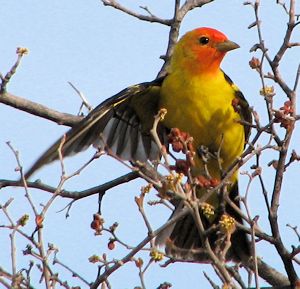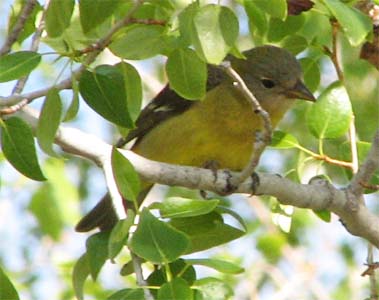- List of Species Observed in RioEmbudoBirds.org area (Updated 2023):
- All Seasons, All Species
- Species Present All Year
- Winter Visitors
- Spring-Fall Transients
- Migrant Summer Breeders
- Non-breeding Vagrants
- Observing Birds
- Local Bird Counts
- Bird Migration
- Bird Song and Sound
Migration
Migration of birds refers to the seasonal movements of birds. It is one of the most interesting aspects of bird behavior. Driven primarily by food availability, some birds make incredible journeys covering thousands of miles. Tiny songbirds weighing only a few ounces make Spring journeys from wintering grounds in South and Central America to the United States and Canada. Sometimes flying for days non-stop across the Gulf of Mexico, these birds will retrace their route in the Fall after the summer breeding season.
One local transient:
 Male Western Tanager
Male Western Tanager El Bosque, Dixon May 8, 2007
Every spring, many people ask about the "beautiful yellow and black bird with the red head". This bird, the Western Tanager (Piranga ludoviciana), passes through the Rio Embudo Area twice each year. It winters in the southern half of Mexico and in Central America. It breeds in the western United States including along the Río Pueblo, el Río Santa Barbara and thel Río de Las Trampas right here in our own watershed.
The first Western Tanagers arrive in Velarde, Embudo and Dixon during the last week of April. On their way to higher elevations locally and to points further north, the wave of tanagers will continue until the first week of June. After that, you will have to go up into the pine forests above Peñasco and Las Trampas to see them.
 Female Western Tanager
Female Western Tanager El Bosque, Dixon May 17, 2008
However, you can just wait at home in Dixon or Velarde. They will be back. The first of the returning migrants will show up in mid July. The "wave" of migrants is more prolonged in the "Fall migration" with Tanagers present until the third week of September.
This is just the barest sketch of one bird species' migration. Every species has its own story to tell.
Wondering why there are no Juncos
in Dixon in the Summer? Take a
drive up to Amole Canyon or a hike
above Aguas Piedras for the answer!
in Dixon in the Summer? Take a
drive up to Amole Canyon or a hike
above Aguas Piedras for the answer!
Raptor Migration:
Raptor migration is a topic that I am particularly interested in. Raptors include Hawks, Eagles, Falcons and Turkey Vultures.
Migrating raptors provide one of the truly spectacular natural wonders of the world. There are raptor count sites where hundreds of thousands of raptors can be seen in one day. In Cardel, Veracruz, Mexico I witnessed a flight of 655,000 raptors on October 7, 2005. There is a month-long period starting the 3rd week of September when the daily average is over 50,000 raptors. For 21 of those days, the average is over 100,000. Migration provides a rare opportunity in nature to see large groups of a single species.
Pronatura Veracruz, a Mexican non-profit conservation organization, manages this raptor count. This location hosts the largest concentration of migrating raptors in the world: Veracruz River of Raptors (Veracruz Río de Rapaces)
Other Raptor MIgration sites that count
more than 1,000,000 individuals
per season:
more than 1,000,000 individuals
per season:
Here are some great sites that have plenty of raptor migration information:
Hawk Mountain Sanctuary
Hawkwatch International
Hawk Migration Association of America
Current data from all of the North American raptor hawk count sites:
HawkCount.org (HMANA)--Current Raptor Migration Data
Direct link to Veracruz data at HawkCount.org (HMANA):
Cardel, Veracruz
Chichicaxtle, Veracruz
Copyright 2006-2021 by Rio Embudo Birds.org --- All rights reserved.

